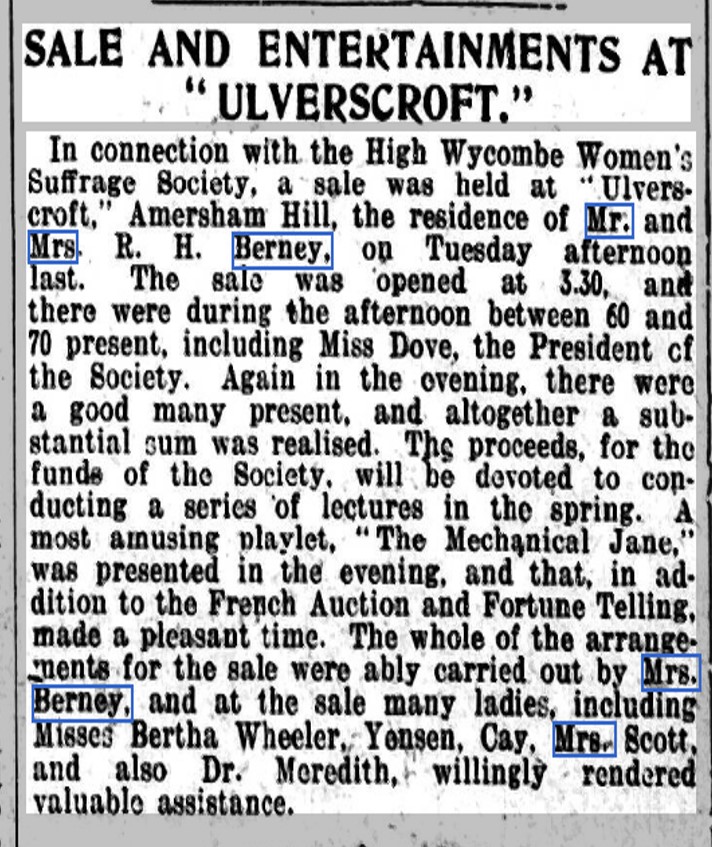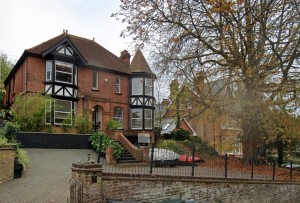Supercali …
In 1896, the snappily titled National Union of Women’s Suffrage Societies (NUWSS) began its work of achieving women’s suffrage in Britain. Its formation ‘followed a conference of some twenty women’s suffrage societies held in October 1896’ https://www.oxforddnb.com/ Millicent Fawcett had chaired the conference and became the de facto leader of the movement.
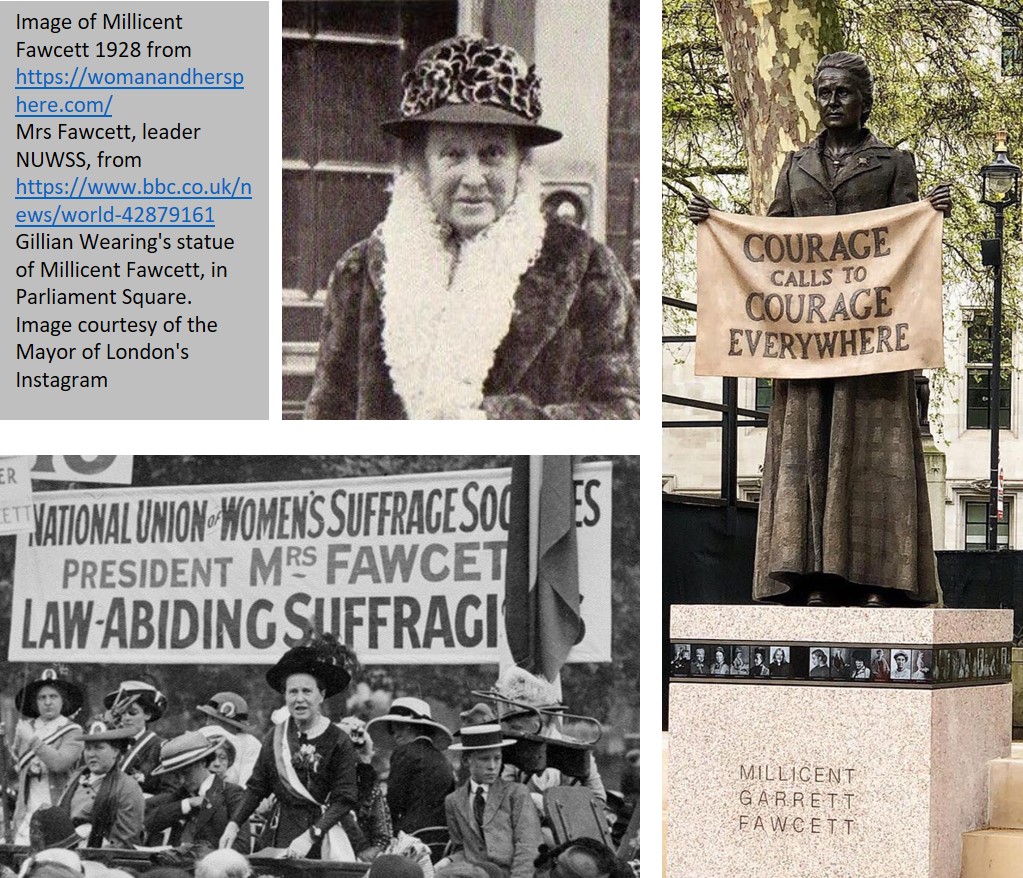
‘’I cannot say I became a suffragist’, she later wrote. ‘I always was one, from the time I was old enough to think at all about the principles of Representative Government’ (NUWSS typescript, n.d., Manchester Central Library, M50/2/10/20) as cited in https://www.oxforddnb.com/
The suffragist campaign for wider suffrage (not just for women) had been peacefully pushing forward for forty years before the suffragettes (WSPU) emerged with their rallying cry of ‘Deeds not Words’. ‘The methods of the NUWSS centred on the education of public opinion and the organization of pressure from parliamentary constituencies’ https://www.oxforddnb.com/ and this did not go far enough, or fast enough, for the WSPU. ‘… its methods also reflected a growing impatience with the strategy of the NUWSS, after a private-member suffrage bill that year was talked out in a spirit of ridicule and contempt.’ Ibid
The epithet ‘suffragettes’ was coined by journalist Charles Hands in 1906 to belittle them.
‘… Adding the diminutive suffix, “-ette,” was meant to minimize these women and distinguish them from “constitutional” suffrage advocates, namely Millicent Fawcett, who relied on “non-militant” efforts including petitioning, lobbying and marches.’ https://suffrage100ma.org/resources/did-you-know-resources/suffragists-or-suffragettes/
The militancy of the suffragettes may have publicised ‘the cause’ but the NUWSS was opposed to it.
More of Edith Berney later.
…fragilistic …
The suffragist movement appealed more to middle class women whereas the WSPU drew also from working class women. The film Mary Poppins (1964) turned the original P L Travers’ creation Mrs Banks from a merely incompetent wife and mother into a ‘suffragette’. It has been suggested that this was a product of the 1960’s fears about strident women and, possibly, because the scripting team comprised only men!

If the campaign had had to rely on Mrs Banks, women would probably still be voteless. With a husband employed by a bank and living a comfortable lifestyle, Mrs Banks would far more likely be a suffragist than a suffragette. “We had the most glorious meeting! Mrs Whitbourne-Allen chained herself to the wheel of the Prime Minister’s carriage!” she declares in the film and yet, by the end, she happily uses her Votes for Women sash for the tail of a kite. If nothing else, Mrs Banks’ colours are all wrong. The NUWSS used the colours of red, white and green and the WPSU employed purple, green and white.
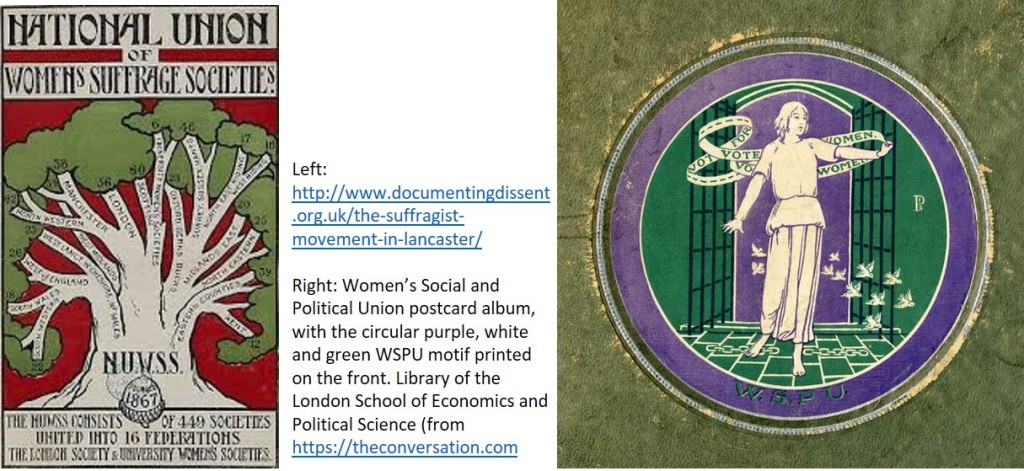
‘Emmeline Pethick-Lawrence, editor of the weekly newspaper, Votes for Women, wrote, ‘Purple as everyone knows is the royal colour, it stands for the royal blood that flows in the veins of every suffragette, the instinct of freedom and dignity…white stands for purity in private and public life…green is the colour of hope and the emblem of spring.’ ’ https://irishwomenshistory.blogspot.com/2014/11/the-colours-of-suffragettes.html
It probably says much for the campaign of the WPSU that today most people know the term ‘suffragette’ and far fewer are aware of the term ‘suffragist’ or of the difference between them. Despite the name of Emmeline Pankhurst being well-known, it is Millicent Fawcett’s quiet and steadfast campaign which has meant that it is she who has a statue today in Parliament Square, not Mrs Pankhurst. Mind you, she is the only woman to be thus commemorated here and it didn’t happen until 2018 so perhaps Mrs Pankhurst’s spirit is quietly triumphant!
…expiali …
How does all this connect with the School? Allow me to introduce Edith Ann Wilson.
Former pupil Edith was born in 1865 in Wakefield, the daughter of Daniel & Jane Wilson. Her father was described as manager of the Calder Soap Works in Thornes, Yorkshire.


The soap works were eventually taken over by Lever brothers (which ultimately became Unilever), not the only time the School and Unilever’s paths crossed as the company used the Weybridge site during the WWII whilst the pupils were moved to Ricky.
At some point after 1861, Daniel appears to have left the soap works and branched out in a business of his own – one assumes in connection with soap manufacturing as he is still described thus in 1871 at 6 Bolton Terrace, Jesmond, Newcastle upon Tyne.
His widow returned to reside at Old Hall, Sandal Magna, until her own death in 1905.
At some point between summer 1872 (when her father died) and 1874 (when there was a funding application made by the Head Governess on behalf of Edith for music lessons), Edith became an RMIG pupil. She clearly gained from her education because she was successful in the Cambridge exams December 1880 (reported in Yorkshire Gazette 1881); had been successful in French and was granted ‘a handsome prize’ for having passed Cambridge Local with Honours (The Era May 1882) and subsequently became the Gold Medallist ‘for general proficiency’ (Yorkshire Gazette May 1881) to which the Wakefield Free Press May 1881 added that she had also gained a prize in Religious Knowledge.
So much for the Head Governess’ earlier assessment of her as ‘an excitable case’!
Edith would have left school in 1881 and possibly initially returned to Sandal but by 1891 she is a teacher at The Westlands private school in Scarborough. Her whereabouts in 1901 is not currently known but on 24th December 1904 at Christ Church, Edinburgh, she married Robert, ‘son of Sir Henry Hanson Berney, 9th Bt.’ http://www.thepeerage.com/p14014.htm. The banns were read in Sandal Magna, St Helen and the marriage announcement declared him to be ‘Robert Henry Berney of Morningside, Edinburgh (born Beaumaris, Anglesey, son of a baronet)’. It seems possible that they were residing in Scotland and where Edith was in 1901 but that is speculation only.
By 1911, the couple were both teaching in Godstowe School and living at Ulverscroft, Amersham Road, High Wycombe. It was while here that Edith became active in the NUWSS. The South Bucks Standard of 24 July 1913 describes her as ‘Mrs R H Berney, the indefatigable Hon Secretary of the High Wycombe branch of the National Union’. But it is clear from other newspaper reports that Edith had been a mover and shaker before this.
Reading across the grain of this tells us that Ulverscroft was clearly a residence of a fair size if 60-70 people could fit in. There is no longer any trace of it under this name but it seems likely to have been one of the large villas that were on the street at the time (such as the one shown), and which may still exist or may not.
In 1913, the first of a series of meetings organised by Edith took place.
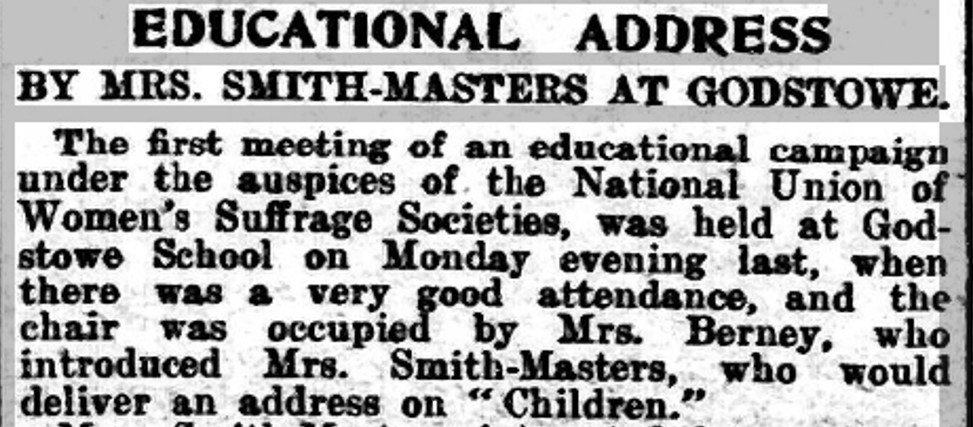
The so called Suffrage Pilgrimage or Great March took place in 1913 and this may explain why there was much interest in such meetings and the drive to raise funds.


The Great March was first mooted in April 1913 and quickly gained momentum. The first marchers set off on 18 June allowing six weeks to reach London for a rally in Hyde Park where ‘78 speakers addressed the crowd from 19 platforms, one for each federation within the NUWSS’. (ibid)
To judge by the number of times her name is recorded in the local press, Edith was rather a Committee animal, motivated by many causes. There are 17 mentions in 1913 alone! After that, she seems to slow down a little and by 1921, the Berneys had moved to Harpenden, Hertfordshire where he (and probably also she) was teaching at St George’s School.

Edith died on 19 October 1937 at the age of 72, survived by her husband who subsequently re-married. And so we reach the end of the line for the ‘indefatigable’ Mrs Berney. The one element in life that it is impossible to defeat is the leaving of it. In 1918 the vote was granted to women over the age of 30, either a member or married to a member of the Local Government Register. About 8.4 million women gained the vote but it probably didn’t include Edith. The ‘excitable case’ (whatever that means) who became a tour de force for ‘The Cause’ locally may have had to wait for a further decade until 1928.
…docious.



